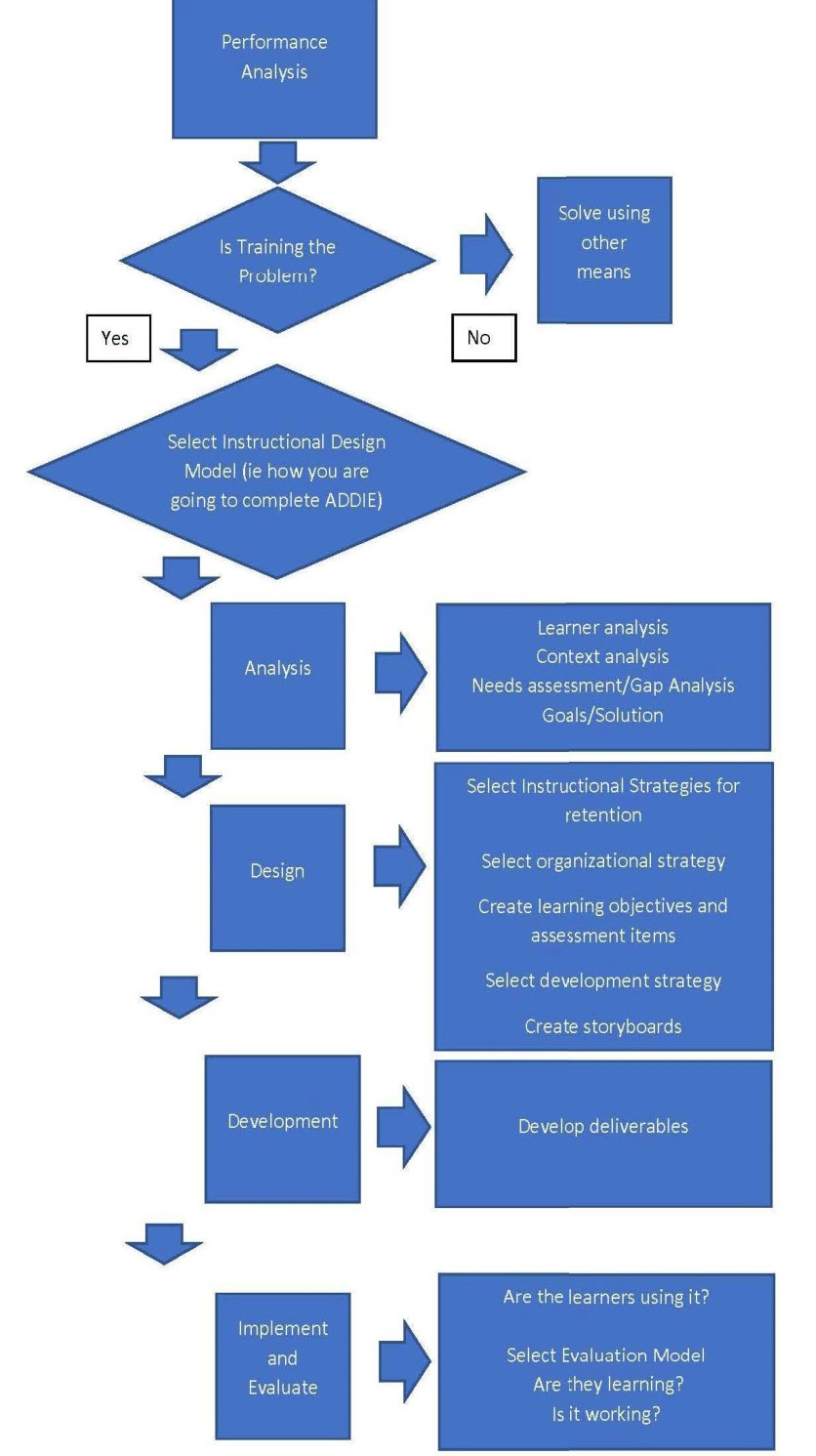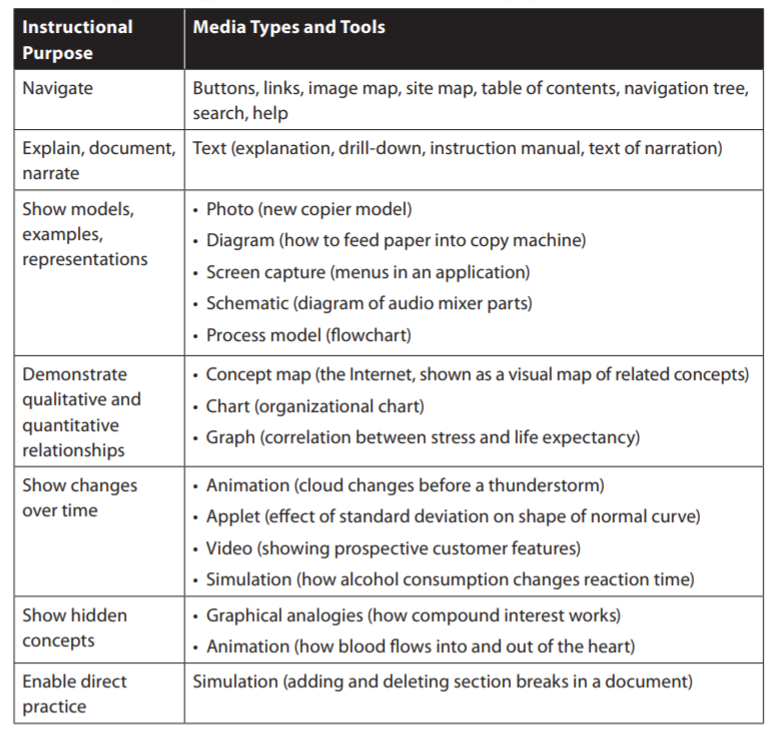Analysis
The instructional designers are typically presented with a problem that may come from different places - the client, data, new software, etc. It is necessary to conduct a performance analysis first to find out what the problem really is, the cause of the problem, and what interventions (solutions) we can use to solve the problem. If the gap caused by training and not by other factors (social and emotional reasons, attitude, environment, etc.), then we proceed with an instructional design approach to solve the problem.

In addition to performance analysis, other types of analysis include:
- Learner analysis – What are the characteristics of the learners?
- Context analysis – In what kind of conditions will the learners be trained and acquire their new skills?
- Gap analysis – What is the current and the desired state?
- Task analysis – What knowledge and skills will the learners acquire? See example.
Design
Learning taxonomies, Learning Objectives and Assessment
After completing task analysis, instructional designers can begin writing learning objectives. To demonstrate that students have achieved the desired outcome, a taxonomy of learning can be useful for defining the types of work that we want our students to do. Popular taxonomies include Bloom’s taxonomy and David Merrill’s Component Display Theory.
One common method to write a learning objective or outcome is the A. B. C. D. method[2]:
- Audience: Who are your learners (who will be doing the performance)?
- Behavior: Describe the task or behavior using action verbs – be sure it is something that can be heard or something that is observable.
- Conditions: Under what conditions (what tools, aids or reference materials can the learner use? Are there things that they won’t be able to use?)
- Degree: To what degree of mastery – how well must it be done (speed, accuracy, quality, etc.)?
An example of learning objectives using the A.B.C.D. method: At the end of the workshop, participants will be able to describe the different types of analysis with 100% accuracy.
| Task | Objective | Assessment |
|---|---|---|
| Describe the different types of analysis | At the end of the workshop, participants will be able to describe the different types of analysis with 100% accuracy. | Please complete the following paragraph by filling in the blanks: Once __ analysis (also called front-end analysis) is completed, we are ready to begin the ‘formal’ instructional design process. Then, we conduct __ analysis (also called gap analysis) to determine how to solve the problem through a combination of the __ analysis, __ analysis, and __ analysis. Lastly, we conduct __ to break down the project goals into skills and knowledge. |
Instructional Strategies
Instructional designers use strategies to ensure that instruction engages learners through teaching/learning activities, such as group discussions, independent reading, case studies, lectures, worksheets, group projects, etc. There are three types of instructional strategies - organizational, delivery, and management[3].
- Organizational strategies are used to sequence instruction and present the content. The most well-known organizational strategy is Gagné’s Nine Events of Instruction(see example). Merrill’s First Principles Of Instruction is another popular organizational strategy.
- Delivery strategies are used to choose instructional medium. Examples include John Keller’s ARCS Model, Problem-Based Learning, chunking, gamification, and more.
Development
Multimedia principles
Richard Mayer is professor of psychology at the University of California, Santa Barbara. In 2001, he set out his principles for multimedia learning, which have become a standardised approach in instructional design methods. Here’s an article on the examples of Mayer’s principles application.
Common Software
| Authoring | Video | Audio | Document | Images |
|---|---|---|---|---|
| Articulate | Camtasia | Audacity | Microsoft Word | Adobe Photoshop |
| Adobe Captivate | Adobe Premiere Pro | Adobe Audition | Adobe InDesign | Adobe Illustrator |
| Final Cut Pro |
Instructional designers use these tools to create deliverables to meet the needs of instruction. Below is a table that shows several example media types and tools for various instructional purposes.

Implementation
During this stage, the materials created during development are introduced to the target audience and the learning process starts. Depending on the chosen format, the implementation stage will likely include the following main steps to a greater or lesser degree:
- Training the instructors
- Preparing the learners
- Preparing the environment
Evaluation
There are two types of evaluations. One is formative evaluation where instructional designers collect data and information during the development of instruction to improve the effectiveness of the instruction. The other one is summative evaluation where evaluators collect data to determine the effectiveness of instruction after its final version is produced. See a comparison of formative and summative evaluation below[5].
For the summative evaluation, we select an evaluation model (i.e., Kirkpatrick’s model). This is where we determine if the learners learned, if they enjoyed the training, if it’s being applied to their job, if it solved the problem, and the return on investment.
| Formative Evaluation | Summative Evaluation | |
|---|---|---|
| Purpose | Locate weaknesses in instruction in order to revise it | Document the degree to which skills learned during instruction transferred to the jobsite |
| Phases or stages | One-to-one; Small group; Impact evaluation | Expert judgment; Impact analysis |
| Position of evaluator | Member of design and development team | Typically an external evaluator |
| Outcomes | A prescription for revising instruction | A report documenting the soundness of the instruction and the impact the instruction had on the work, the job, and the organization |
Pastore, R. (2020). The instructional design and development process: A ‘how to’ guide for practitioners. Kindle Direct Publishing.
Heinich, R. (1996). Instructional media and technologies for learning. Merrill.
Smith, P. L., & Ragan, Tillman J. (2005). Instructional design. John Wiley & Sons, Inc.
Shank, P. (2008). The value of multimedia in learning. The eLearning Guild.
Dick, W., Carey, Lou., & Carey, James O. (2015). The systematic design of instruction. Pearson.